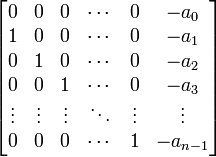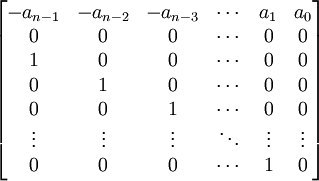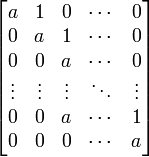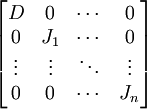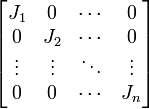Engineering Analysis/Matrix Forms
< Engineering AnalysisMatrices that follow certain predefined formats are useful in a number of computations. We will discuss some of the common matrix formats here. Later chapters will show how these formats are used in calculations and analysis.
Diagonal Matrix
A diagonal matrix is a matrix such that:
In otherwords, all the elements off the main diagonal are zero, and the diagonal elements may be (but don't need to be) non-zero.
Companion Form Matrix
If we have the following characteristic polynomial for a matrix:
We can create a companion form matrix in one of two ways:
Or, we can also write it as:
Jordan Canonical Form
To discuss the Jordan canonical form, we first need to introduce the idea of the Jordan Block:
Jordan Blocks
A jordan block is a square matrix such that all the diagonal elements are equal, and all the super-diagonal elements (the elements directly above the diagonal elements) are all 1. To illustrate this, here is an example of an n-dimensional jordan block:
Canonical Form
A square matrix is in Jordan Canonical form, if it is a diagonal matrix, or if it has one of the following two block-diagonal forms:
Or:
The where the D element is a diagonal block matrix, and the J blocks are in Jordan block form.


